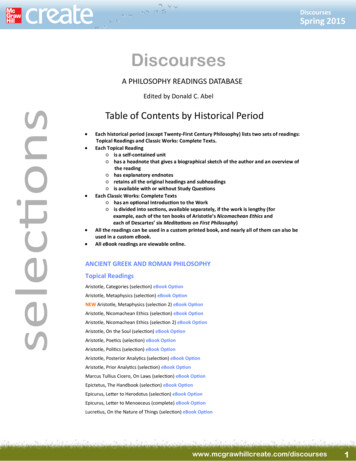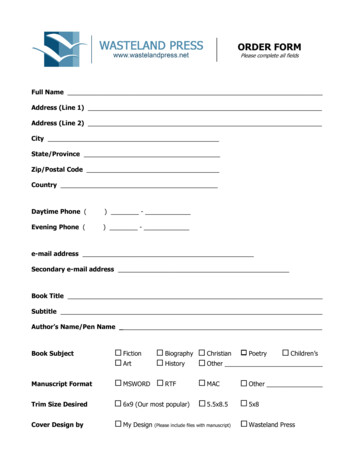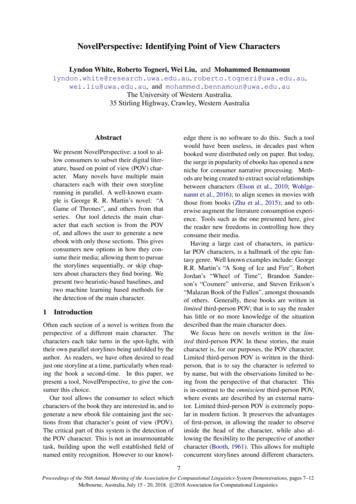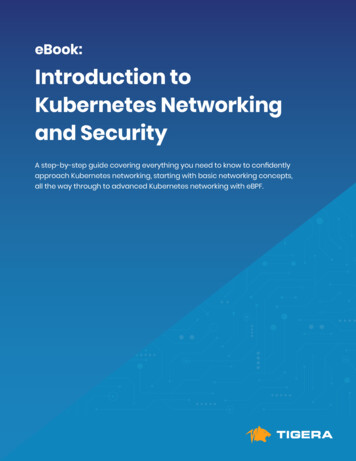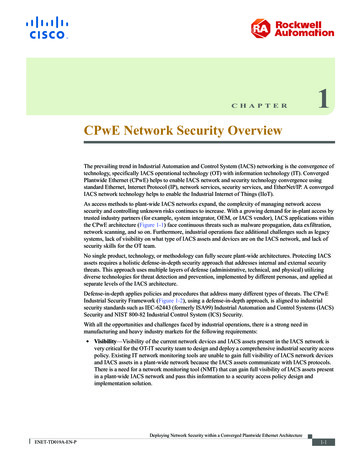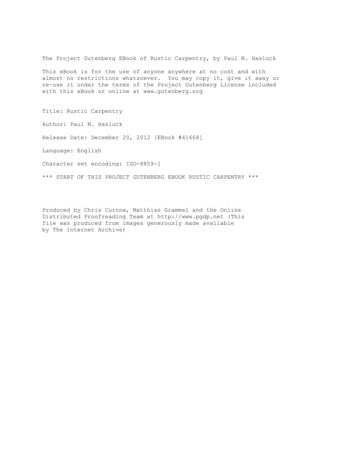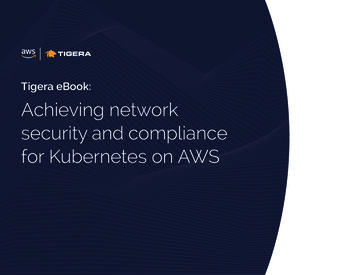
Transcription
Tigera eBook:Achieving networksecurity and compliancefor Kubernetes on AWS
Table of ContentsIntroduction . 3Why organizations are adopting containers on the cloud . 4Why leverage Kubernetes?. 5Running Kubernetes on AWS. 6Amazon Elastic Compute Cloud (Amazon EC2). 6Amazon Elastic Container Service for Kubernetes (Amazon EKS). 6Amazon Elastic Container Registry (Amazon ECR). 6Why Kubernetes requires a new approach to network security and compliance . 7Enabling network security and compliance for Kubernetes on AWS with Tigera . 8Zero trust network security . 9Visibility and traceability . 11Enterprise control and continuous compliance . 13Customer success story: Atlassian . 15Resources and getting started . 16Achieving network security and compliance for Kubernetes on AWS 2
IntroductionModern applications are being broken down into smaller pieces and/orarchitectures. Now, services are communicating with each other, making themdependent on the network to operate. These microservices architectures havesignificantly more components, meaning more extensive network securitymeasures are needed. They are also deployed in highly dynamic, automatedenvironments with ephemeral addresses which makes the question of workloadidentity a critical one for enforcing security.Achieving network security and compliance for Kubernetes on AWS 3
Why organizations are adopting containers on the cloudContainers provide a standard way to package your application’s code, configurations, and dependencies into a single object. This objectcan be used to execute quick, reliable, and consistent deployments, regardless of the environment.Ship more software fasterStandardize operationsSave moneyAchieving network security and compliance for Kubernetes on AWS 4
Why leverage Kubernetes?Kubernetes allows you to deploy and manage containerized applications at scale, using the same toolset for your on-premises and cloudenvironments. It manages clusters of compute instances and scheduling containers, so you can run containers with automated processesfor deployment, maintenance, and scaling.Run applications at scaleRun anywhereKubernetes allows you to define complex containerizedapplications and run them across a cluster of servers toscale alongside your businessKubernetes empowers you to run highly available andscalable Kubernetes clusters on Amazon Web Services(AWS), while maintaining full compatibility with your onpremises deployments.Seamlessly move applicationsAdd new functionalityYou can utilize the same tooling on-premises and onthe cloud to move containerized applications from localdevelopment machines into production.As an open source project, new functionality is constantlybeing added to the platform by its large community ofdevelopers and technology companies.Achieving network security and compliance for Kubernetes on AWS 5
Running Kubernetes on AWSAWS provides infrastructure resources designed to run containers, as well as a set of orchestration servicesthat make it easy for you to build and run containerized applications in production. Whether you want tomanage the Kubernetes infrastructure yourself, or take advantage of fully managed services, you gain thesecurity, scalability, and high-availability of AWS, with integrations to its powerful native services.Use cases:Amazon Elastic Compute Cloud (Amazon EC2)For users who want to fully manage their own Kubernetes deployment, you can provision and run Kubernetesof your choice of powerful instance types. There are many open source projects that enable you to more easilyrun Kubernetes on Amazon EC2, such as Kubernetes Operations (kops). MicroservicesHybrid container deploymentsBatch processingApplication migrationAmazon Elastic Container Service for Kubernetes (Amazon EKS)Amazon EKS provides you with fully managed Kubernetes infrastructure, so you can run Kubernetes withoutneeding to provision or manage master instances and etcd.Amazon Elastic Container Registry (Amazon ECR)Amazon ECR enables you to store, encrypt, and manage container images for faster deploymentsAchieving network security and compliance for Kubernetes on AWS 6
Why Kubernetes requires a new approachto network security and complianceThe vision behind Kubernetes is rapid application deployment, where services mesh development and testwith production. This cannot truly be realized if security and networking teams must be brought into the foldfor every application deployment.Complex network securityKubernetes heavily relies on the network and generates significant east-west traffic,creating a greater attack surface than traditional architectures, requiring moredynamic security and compliance controls.Limited of visibilityApplications running on Kubernetes platforms are constantly changing IP addressesand locations, making it difficult to use traditional log flows to debug issues andinvestigate anomalous activity.Complicated compliance measuresDynamic application environments render periodic audits insufficient, as auditors requireproof of network and security policy enforcement amid ever-changing conditions.Achieving network security and compliance for Kubernetes on AWS 7
Enabling network security and compliancefor Kubernetes on AWS with TigeraOrganizations running their workloads on AWS are responsible for anything running on top of cloud infrastructure, whereas AWS isresponsible for the base-line infrastructure itself. Tigera complements native AWS services, delivering automated orchestration forcontainerized microservices, so developers can create scalable, secure, and reliable applications.Zero trust network securityVisibility and traceabilityEnterprise control andcontinuous complianceAchieving network security and compliance for Kubernetes on AWS 8
Zero trust network securityTigera operates under the assumption that your services, network, users – and anything else related to your environment – are potentiallycompromised. It delivers a layered defense model on top of your existing network to lock down your Kubernetes workloads, withoutrequiring any code or configuration changes.Multiple sources of identityTigera’s Zero Trust Security model authenticates theidentity of every request based on multiple sources,including the L3 network identity and x509 certificatebased cryptographic identity.Multiple enforcements pointsTigera’s declarative, intent-based policies are enforced atmultiple points – including the host, container, and edgelayers of the application.Multiple layers of encryptionEncryption can be enabled for all traffic within and acrossall environments, leveraging mutual Transport LayerSecurity (mTLS) for application and edge layers and IPsecfor traffic between hosts.Achieving network security and compliance for Kubernetes on AWS 9
Zero trust network securityBusiness use case: AWS security groups and Kubernetes policy integrationWhen deploying Kubernetes on AWS, all Kubernetes pods have the same security groups as the host/node they are on (and vice versa).AWS security groups are the standard approach to network security for Amazon Virtual Private Cloud (Amazon VPC) resources. Tigera serves as the model for thestandard Kubernetes Network Policy, and natively integrates with AWS security groups, providing more fine-grained policy controls on top of your existing AWS policies.Combined, AWS and Tigera enable you to achieve a universal approach to security policies, securing your applications Amazon RDSContainerContainerapp2DynamoDBEC2 InstancesAmazon S3Figure 1: AWS security groups and Kubernetes policy integrationAchieving network security and compliance for Kubernetes on AWS 10
Visibility and traceabilityTigera integrates to Amazon CloudWatch, and other AWS services, for comprehensive visibility across your containerized environments.Some of the key capabilities including network visibility, compliance monitoring, and scanning of the network for illegitimate traffic andindicators of compromise (IoC).Accurate network flow loggingTigera captures flow logs with full context, includingKubernetes labels at the application and containerinterface, providing you with the data required for PCI,HIPAA, GDPR, and other compliance frameworks.Security forensics for KubernetesModern search and visualization capabilities providereal-time enterprise-wide visibility into Kubernetestraffic, empowering you to discover and identifycommunications between Kubernetes microservices tobetter support DevOps and Security teams’ objectives.Automated remediationTigera is constantly monitoring traffic for anomalies, withbuilt in alerting. In case of a compromise, it automaticallyremediates the issue by applying a quarantine to thecontainer, prohibiting any lateral movement.Achieving network security and compliance for Kubernetes on AWS 11
Visibility and traceabilityBusiness use case: Visualization and CloudWatch network flow logTigera goes beyond traditional 5-tuple flow logs, which require additional context and correlation. It captures denied traffic at the container level, and appends workloadmetadata into the flow logs. For Kubernetes environments, such as Amazon EKS, Tigera generates bi-directional flow logs for all pods, and host connections, eachincluding workload identity, pod labels, and host labels.Figure 2: Integration with CloudWatch for metrics and audit logsAchieving network security and compliance for Kubernetes on AWS 12
Enterprise control and continuous complianceTigera delivers ongoing compliance and cross-functional collaboration capabilities, including the ability to extract data required for ITaudits of Amazon EKS and other Kubernetes environments running on AWS.Workload identityWorkloads authenticate and authorize based on a seriesof attributes, including network and cryptographicidentity (equivalent to two-factor authentication forworkloads). All network flows are logged with thenecessary workload identity and metadata information todemonstrate compliance with security policies.Audit loggingAll changes to security policies are logged. Combinedwith Tigera flow logging, you can quickly and easilydemonstrate what policies are in place, and the historyof enforcement.Tiered security policiesTiered policy capabilities enable teams to collaborate ondefining and implementing policies, without introducingdependencies on each other.Achieving network security and compliance for Kubernetes on AWS 13
Enterprise control and continuous complianceBusiness use case: Taking a tiered approach for security and compliance across teamsThe flexibility of Tigera’s tiered security approach makes it possible for your teams to concurrently set policies without changing others’ workflows. For example, whileyour Information Security (InfoSec) team is creating policies preventing access for known bad actors, your networking team can prevent access between productionand development nodes, and your application teams can define which services have access to other URLs and HTTP Methods. This yields more agile operations, with agreater security and compliance posture.Figure 3: Tired security policy implementationAchieving network security and compliance for Kubernetes on AWS 14
Customer success story: AtlassianFounded in 2002, Atlassian serves more than 125,000 customers around the world. The company delivers a suite of Software-as-a-Service (SaaS)products that enable efficient communication and collaboration across teams, with popular services such as JIRA, Confluence, and BitBucket.ChallengeNext stepsAtlassian’s traditional approach was not efficient or scalable enough to continue,with deployments taking more than 24 hours and full data centers of unusedequipment and large amounts of unused capacity. They chose to moveoperations to the cloud, seeking to consolidate its compute resources and rearchitect its applications for multi-tenancy with Kubernetes. An added layer ofcomplexity is that it hosts arbitrary code execution – a difficult, high-risk securityscenario to manage – which is even riskier with multi-tenancy and shared blastradii between customers.All in all, as Atlassian continues to adopt microservices, they are looking toimplement some of the richer functionality of Tigera. Atlassian is working closelywith Tigera to extend its functionality to Windows-based workloads, and built outmore intelligent traffic management on a per-application basis.SolutionAWS enabled Atlassian to consolidate its compute resources, and run theirworkloads on managed clusters, simplifying operations for other teams. Theyleveraged Tigera Calico to define and enforce policies across their Kubernetesworkloads, with security groups on each node to restrict access to sensitive areasof the platform. This helped to reduce the blast radius of their workloads, whiledecreasing application downtime for their customers.Results Stopped a bitcoin mining cyber-attack in less than 15 minutes Improved deployment efficiency, up to 800% with some services Security and compliance policy changes can be made in minutes, instead of hours“We can programmatically alter andenlarge or add new IPs, or removeIPs from our Tigera rules. That’s a realbenefit to using Tigera for us, it playsreal nicely with our CI/CD pipeline we can make changes in minutes”– Chris Johnston, Kubernetes PlatformSenior Team Lead at Atlassian Improved IT agility by streamlining the application of network security policieson-premises and on AWSAchieving network security and compliance for Kubernetes on AWS 15
Resources and getting startedDo you have a question about network security for Kubernetes? Are you interested in setting up a demo, or free trial?We’d love to hear from you!Contact us30-day free trialTigera Secure Cloud Edition has a 30-day free trial for Kubernetes on AWS,and Amazon EKS.Sign upGetting startedTigera Secure Cloud Edition can be deployed within minutes,via AWS Marketplace.Get started 2019 Tigera, Inc. All rights reserved 2019, Amazon Web Services, Inc. or its affiliates. All rights reserved.Achieving network security and compliance for Kubernetes on AWS 16
Achieving network security and compliance for Kubernetes on AWS 7 Why Kubernetes requires a new approach to network security and compliance The vision behind Kubernetes is rapid application deployment, where services mesh development and test with production.
